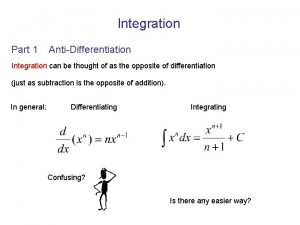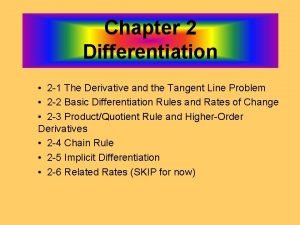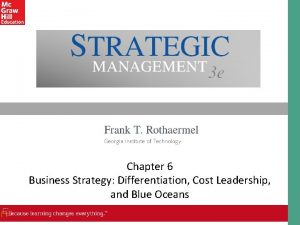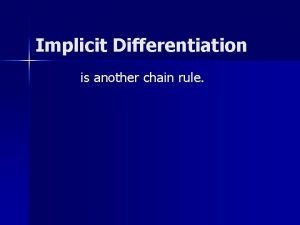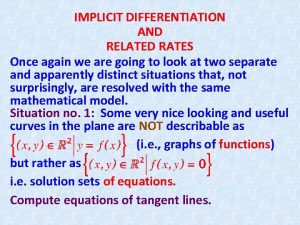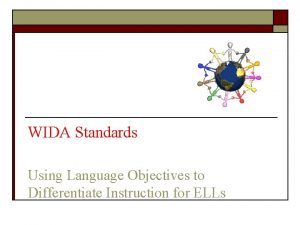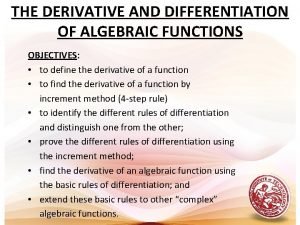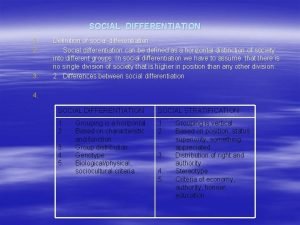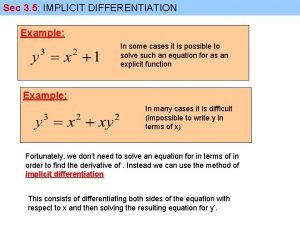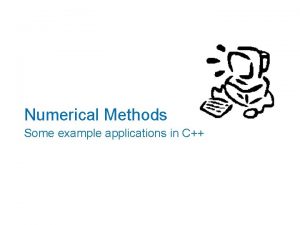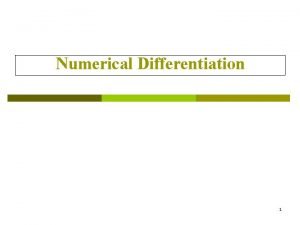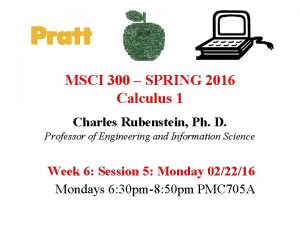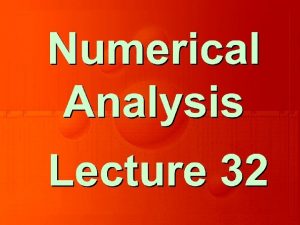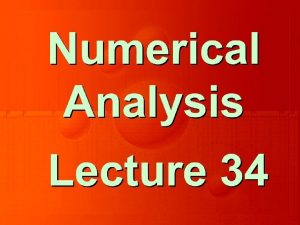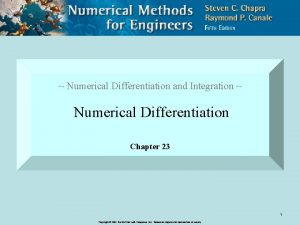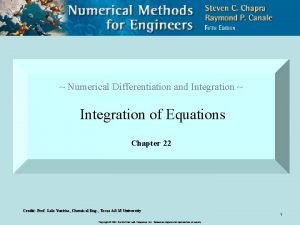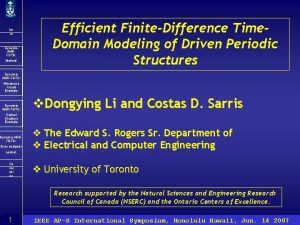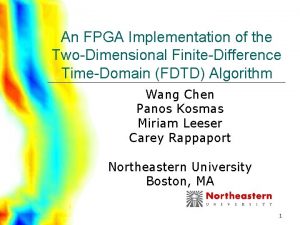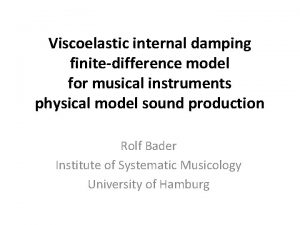Chapter 7 Differentiation and Integration Finitedifference differentiation 1




































- Slides: 36

Chapter 7 Differentiation and Integration • Finite-difference differentiation 1

Example: Evaporation Rates Table: Saturation Vapor Pressure (es) in mm Hg as a Function of Temperature (T) in °C T(°C) 20 21 22 23 24 25 es(mm Hg) 17. 53 18. 65 19. 82 21. 05 22. 37 23. 75 2

The slope of the saturation vapor pressure curve at 22°C (3 methods) : The true value is 1. 20 mm Hg/°C, so the two-step method provides the most accurate estimate. 3

Differentiation Using a Finitedifference Table Example: Finite-difference Table for Specific Enthalpy (h) in Btu/lb and Temperature (T) in ºF T h 800 1305 Δh Δ 2 h Δ 3 h Δ 4 h 155 1000 1460 -30 125 1200 1585 25 -5 120 1400 1705 -20 5 0 120 1600 1825 4

• For example, at a temperature of 1200 ºF, the forward, backward, and two-step methods yield: • The rate of change of cp at T= 1200 ºF is 5

Differentiating an Interpolating Polynomial The derivative: Gregory-Newton interpolation polynomial: It is more difficult to evaluate the derivative: 6

Differentiation Using Taylor Series Expansion 7

• The second-order approximation: The second-order approximation of the first derivative with forward difference: 8

• The second-order approximation of the second derivative with forward difference: • The first-order and second-order approximation of the first derivative with backward difference: 9

• The first-order and second-order approximation of the second derivative with backward difference: • How to derive (for reference only) 10

• The first-order and second-order approximation of the first derivative with the two-step method: • The first-order and second-order approximation of second derivative with the two-step method: 11

Example: Evaporation Rates Second-order with forward, backward, two-step: The true value at T = 22ºC is 1. 2 mm Hg/ºC 12

Numerical Integration • The area under the curve f(x) between x=a and x=b: • Example: the volume rate of flow (Q) of water in a channel or through a pipe is the integral of the velocity (V) and the incremental area (d. A): 13

Interpolation Formula Approach The Gregory-Newton interpolation polynomial: 14

Trapezoidal Rule 15

• Another way to get the trapezoidal formula The linear polynomial passing the data points: 16

• The absolute value of the upper bound on the error for the Trapezoidal rule is: 17

Example: Trapezoidal Rule for Integration • n=4 • The trapezoidal rule provides 18

19

Example: Flow Rate • The flow rate (Q) of an incompressible fluid is given by the integral. in which V is the velocity and A is the area. • For a circular pipe of radius r, the incremental area d. A is equal to 2πrdr. 20

• Table 6: The Data for Estimating the Flow Rate of a Fluid in a Circular Piple i ri (ft) Vi (fps) 1 0 10. 000 2 1/12 9. 722 3 1/6 8. 889 4 1/4 7. 500 5 1/3 5. 556 6 5/12 3. 056 7 1/2 0. 21

• For a pipe of diameter of 1 ft trapezoidal rule: 22

Simpson’s Rule • Simpson’s rule: where • Simpson’s rule can only be applied when there an even number of subintervals: 23

• Proof of Simpson’s Rule Using a second-order polynomial: 24

Passing through the three data points: Then, we can obtain the Simpson’s formula. 25

• The absolute value of the upper bound on the error for the Simpson’s rule is estimated by 26

Example: Flow Rate Problem • Applying Simpson’s rule to the data of Table. 6 27

Romberg Integration • Denoting the trapezoidal estimate as I 01 where a and b are the start and end of an interval. • A second estimate I 11: 28

• A third estimate I 21 can be obtained using three equally spaced intermediate points m 1, m 2, and m 3 and it can be rewritten as 29

• Continuing this subdividing of the interval leads to the following recursive relationship • The general extrapolation formula in recursive form is 30

• The values of Iij can be presented in the following upper-triangular matrix form: I 01 I 02 I 03 I 04 … I 0, N-1 I 0, N I 11 I 12 I 13 . … I 1, N-1 I 1, N I 21 I 22 . . … I 2, N-1 I 31 . . . . IN-2, 3 . IN-1, 2 I 0, N+1 IN 1 31

Example: Romberg Method for Integration • For the function f(u) = ueku, the integral is • Let k = 2, we want to calculate The true value of the integral is 2. 097264 (seven significant digits). 32

We have a=0, b=1. 33

34

Table. 7 Computations According to the Romberg Method i j=1 2 3 4 5 6 0 3. 69453 2. 13760 2. 09759 2. 09727 2. 09726 1 2. 52683 2. 10009 2. 09727 2. 09726 2 2. 20678 2. 09745 2. 09726 3 2. 12478 2. 09726 4 2. 10415 2. 09727 5 2. 09899 35

• Similarly for i = 5, I 51=2. 09899 • I 02 is computed as following: • I 03 is computed as following: • The Romberg method yields an exact value to six significant digits for the integral of 2. 09726 36
 Integral by part
Integral by part Three dimensions of corporate strategy
Three dimensions of corporate strategy Make or buy continuum
Make or buy continuum Simultaneous integration examples
Simultaneous integration examples Chapter 2 differentiation
Chapter 2 differentiation Chapter 17 nomadic empires and eurasian integration
Chapter 17 nomadic empires and eurasian integration Chapter 17 nomadic empires and eurasian integration
Chapter 17 nomadic empires and eurasian integration Chapter 18 nomadic empires and eurasian integration
Chapter 18 nomadic empires and eurasian integration Chapter 17 nomadic empires and eurasian integration
Chapter 17 nomadic empires and eurasian integration Directing and managing project execution
Directing and managing project execution Chapter 7 techniques of integration
Chapter 7 techniques of integration Difference between udl and differentiation
Difference between udl and differentiation Porter's competitive strategies
Porter's competitive strategies Delayed differentiation and modular design
Delayed differentiation and modular design Two fundamental business strategies are
Two fundamental business strategies are How jcpenney sailed into a red ocean
How jcpenney sailed into a red ocean Differences between products and services
Differences between products and services Positioning involves meeting consumers lower performance
Positioning involves meeting consumers lower performance Implicit differentiation vs chain rule
Implicit differentiation vs chain rule Segmentation targeting differentiation and positioning
Segmentation targeting differentiation and positioning Cellular adaptation of growth and differentiation
Cellular adaptation of growth and differentiation Cellular adaptation of growth and differentiation
Cellular adaptation of growth and differentiation Implicit differentiation and related rates
Implicit differentiation and related rates Designs may be frozen with too many imperfections remaining
Designs may be frozen with too many imperfections remaining Wida language objectives
Wida language objectives High accuracy differentiation formulas
High accuracy differentiation formulas Derivatives of algebraic functions
Derivatives of algebraic functions Define social differentiation
Define social differentiation Texas teacher goal setting examples
Texas teacher goal setting examples Velocity function
Velocity function What is implicit differentiation
What is implicit differentiation Differentiation of 1/x
Differentiation of 1/x Orthogonal unit differentiation
Orthogonal unit differentiation C programming for newton raphson method
C programming for newton raphson method Numerical derivative example
Numerical derivative example Reciprocal rule differentiation
Reciprocal rule differentiation Carpet patch differentiation
Carpet patch differentiation
